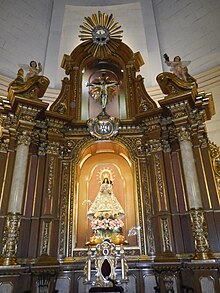Our Lady of the Abandoned Parish
| Diocesan Shrine and Parish of Our Lady of the Abandoned (Dambana ng Ina ng mga Walang Mag-Ampon) |
|
|---|---|
 |
|
| Basic information | |
| Location | J.P. Rizal cor. V. Gomez Sts., Santa Elena, Marikina, Philippines |
| Affiliation | Roman Catholic |
| Country | Philippines |
| Year consecrated | 1690 |
| Ecclesiastical or organizational status | Diocesan (Antipolo) |
| Leadership | Rev. Msgr. Pedro C. Cañonero, Rector and Parish Priest |
| Architectural description | |
| Architectural type | Baroque Church |
| Architectural style | Baroque |
| Completed | 1572 |
| Materials | Adobe, Sand, gravel, cement, mortar and steel |
Coordinates: 14°22′30″N 121°32′46″E / 14.3750°N 121.546°E
The Diocesan Shrine and Parish of Our Lady of the Abandoned (Spanish: Santuario y Parroquia del Nuestra Señora de los Desamparados; Tagalog: Dambana at Parokya ng Ina ng mga Walang Mag-Ampon) is a Roman Catholic church in Marikina, the Philippines. The church enshrines one of several images of the Virgin Mary venerated as miraculous, which has received Papal recognition.
The church itself is a testament of a religious controversy rooting back from Marikina's early history wherein both the Jesuits and Augustinians fought over the ecclesiastical control of the area. The church is also known for featuring Metro Manila's Longest Holy Week Processions with around 70 floats as of 2017, and the third overall after the St Augustine Parish in the Town of Baliuag and the San Isidro Labrador Parish in the Town of Pulilan, both located in the province of Bulacan and featuring at least 110 floats.
Catholicism in what is now Marikina began when the settlement was again ceded to the Augustinians by the Jesuits. On March 10, 1687, Governor Gabriel Cruz Elasque ordered the transfer of Marikina to the oversight of the Augustinians and merged with the ministry of San Mateo. He instructed Don Juan Pimentel, the Mayor of Tondo, to vacate and demolish the visita of Jesús de la Peña as the Marikina River would flood the site during the rainy season. The visita could not accommodate the growing congregation, forcing the Austin friars to transfer operations across the Marikina to higher ground, where the much larger, present structure was built. The church was subsequently made an independent parish in 1690.
...
Wikipedia
